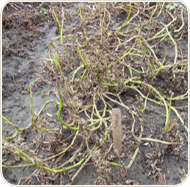Potato Late Blight



My research project focuses on the broad-spectrum late blight resistance gene RB (also known as Rpi-blb1), cloned from diploid wild potato species Solanum bulbocastanum. RB confers partial resistance to multiple isolates of Phytophthora infestans by recognizing some members of a pathogen effector family IPI-O. RB belongs to the largest class of characterized resistance genes, encoding putatively cytoplasmic proteins with coiled coil, nucleotide binding sites and leucine-rich repeats (CC-NB-LRR). The P. infestans effectors IPI-O1 and IPI-O2 are recognized by RB and elicit a hypersensitive cell death response (HR) upon recognition, however another family member IPI-O4 escapes recognition by RB. My aim is to understand the molecular interactions that allow RB to recognize late blight proteins, with the hope to increase late blight resistance in plants through identification and deployment of naturally occurring or engineered RB genes.
In potato, we have characterized the RB resistance phenotype using molecular biology and microscopy (Chen and Halterman, 2011). Our results suggest that suppression of certain defense-related genes may allow P. infestans to spread beyond the site of infection in the partially resistant host despite elicitation of the HR. Related results suggest that the IPI-O4 effector is able to suppress RB activity (Halterman et al., 2010). When IPI-O4 and IPI-O1 are coexpressed, no HR is observed in the presence of RB, which suggests a mechanism by which IPI-O4 can not only elude detection by RB but also actively affect RB function. In order to better understand this phenomenon, I have also performed protein-protein experiments to detect the interaction between RB and IPI-O effectors. The results suggest a physical interaction between the RB CC domain and IPI-O4, but no such interaction was observed with IPI-O1. By comparing the amino acid sequences of IPI-O1 and IPI-O4 and using site-directed mutagenesis, I identified four critical amino acids that play an important role in RB CC and IPI-O4 interaction. Mutations with each of the four amino acids that break down the interaction with the RBCC domain also fails to suppress HR induced by IPI-O1 to some extent. One of the amino acids, at position 129, determines hypersensitive response elicitation in planta. IPI-O mutant L129P fails to induce HR in the presence of RB while IPI-O4 P129L gains the ability to induce an HR. Like IPI-O4, IPI-O1 L129P is also able to suppress the HR mediated by RB, indicating a critical step in the evolution of the gene family.
Our work now is focused on identifying naturally occurring and engineered variants of RB that cannot be suppressed by IPI-O effectors. Pyramiding of RB, RB orthologs, and modified RB recognizing different IPI-O variants is one strategy that could be used to expand the durability of this gene.
